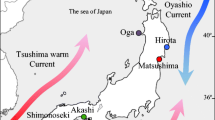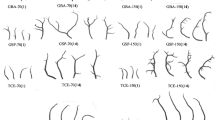Abstract
Comparison of cultured sporophytes and gametophytes in common-garden experiments confirmed the existence of ecotypic differences in light-related traits among populations ofLaminaria saccharina (L.) Lamour. Cultured sporophytes from the turbid habitat in Long Island Sound, New York, USA, grew faster under both limiting and saturating daily irradiances than sporophytes from shallow and deep habitats along the Atlantic coast of Maine. Rapid growth of turbid plants was attributable to several factors, including high photosynthetic capacity and efficiency [due to differences in photosynthetic unit (PSU) number and size], low respiration rates, and high surface area:weight ratios. In contrast to sporophytes, microscopic gametophytes from the three kelp populations grew at similar rates under limiting and saturating daily irradiances. Biomass-specific photosynthesis vs irradiance (PI) parameters were similar for gametophytes from the shallow, deep, and turbid sites, despite population differences in chlorophyll-specific PI parameters and PSU characteristics. However, turbid gametophytes produced microscopic sporophytes more rapidly than gametophytes from the shallow and deep sites, apparently due to a lower blue-light requirement for gametogenesis. Ecotypic differences in sporophytes and gametophytes ofL. saccharina from shallow, deep, and turbid habitats can be understood as phase-specific adaptations.
Similar content being viewed by others
Literature cited
Anderson, E. K., North, W. J. (1966). In situ studies of spore production and dispersal in the giant kelp,Macrocystis. Proc. 5th int. Seaweed Symp. (Halifax) 5: 73–86 [Young, E. G., McLachlan, J. L. (eds.) Pergamon Press, Oxford]
Bolton, J. J., Anderson, R. J. (1987). Temperature tolerances of two southern AfricanEcklonia species (Alariaceae: Laminariales) and of hybrids between them. Mar. Biol. 96: 293–297
Bolton, J. J., Germann, I., Lüning, K. (1983). Hybridization between Atlantic and Pacific representatives of the Simplices section ofLaminaria (Phaeophyta). Phycologia 22: 133–140
Bolton, J. J., Levitt, G. J. (1985). Light and temperature requirements for growth and reproduction in gametophytes ofEcklonia maxima (Alariaceae: Laminariales). Mar. Biol. 87: 131–135
Bolton, J. J., Lüning, K. (1982). Optimal growth and maximal survival temperatures of AtlanticLaminaria species (Phaeophyta) in culture. Mar. Biol. 66: 89–94
Chapman, A.R. O. (1974). The genetic basis of morphological differentiation in someLaminaria populations. Mar. Biol. 24: 85–91
Chapman, A. R. O. (1986). Age versus stage: an analysis of age- and size-specific mortality and reproduction in a population ofLaminaria longicruris Pyl. J. exp. mar. Biol. Ecol. 97: 113–122
Chow, W. S., Anderson, J. M., Hope, A. B. (1988). Variable stoichiometries of photosystem II to photosystem I reaction centres. Photosynthesis Res. 17: 277–281
Clayton, M. N. (1988) Evolution and life histories of brown algae. Botanica mar. 31: 379–387
Dring, M. J. (1987). Marine plants and blue light. In: Senger, H. (ed.) Blue light responses: phenomena and occurrence in plants and microorganisms, Vol. II. CRC Press, Boca Raton, p. 121–140
Dubinsky, Z., Berman, T. (1979). Seasonal changes in the spectral composition of downwelling irradiance in Lake Kinneret (Israel). Limnol. Oceanogr. 24: 652–663
Duncan, M. J., Harrison, P. J. (1982). Comparison of solvents for extracting chlorophylls from marine macrophytes. Botanica mar. 25: 445–447
Espinoza, J., Chapman, A. R. O. (1983). Ecotypic differentiation ofLaminaria longicruris in relation to seawater nitrate concentration. Mar. Biol. 74: 213–218
Falkowski, P. G., Dubinsky, Z., Wyman, K. (1985). Growth-irradiance relationships in phytoplankton. Limnol. Oceanogr. 30: 311–321
Falkowski, P. G., Owens, T. G., Ley, A. C., Mauzerall, D. C. (1981). Effects of growth irradiance levels on the ratio of reaction centers in two species of marine phytoplankton. Pl. Physiol., Lancaster 68: 969–973
Gerard, V. A. (1988). Ecotypic differentiation in light-related traits of the kelpLaminaria saccharina. Mar. Biol. 97: 25–36
Gerard, V. A., Du Bois, K. R. (1988). Temperature ecotypes near the southern boundary of the kelpLaminaria saccharina. Mar. Biol. 97: 575–580
Gerard, V. A., Du Bois, K., Greene, R. (1987). Growth responses of twoLaminaria saccharina populations to environmental variation. Hydrobiologia 151/152: 229–232
Hoffmann, A. J., Santelices, B. (1982). Effects of light intensity and nutrients on gametophytes and gametogenesis ofLessonia nigrescens Bory (Phaeophyta). J. exp. mar. Biol. Ecol. 60: 77–89
Kain, J. M. (1964). Aspects of the biology ofLaminaria hyperborea. III. Survival and growth of gametophytes. J. mar. biol. Ass. U.K. 44: 415–433
Kain, J. M. (1969). The biology ofLaminaria hyperborea. V. Comparison with early stages of competitors. J. mar. biol. Ass. U.K. 49: 455–473
Kain, J. M. (1979). A view of the genusLaminaria. Oceanogr. mar. Biol. A. Rev. 17: 101–161
Larkum, A. W. D., Barrett, J. (1983). Light-harvesting processes in algae. Adv. bot. Res. 10: 1–219
Lee, J. A., Brinkuis, B. H. (1986). Reproductive phenology ofLaminaria saccharina (L.) Lamour. (Phaeophyta) at the southern limit of its distribution in the northwestern Atlantic Ocean. J. Phycol. 22: 276–285
Lee, J. A., Brinkhuis, B. H. (1988). Seasonal light and temperature interaction effects on development ofLaminaria saccharina (Phaeophyta) gametophytes and juvenile sporophytes. J. Phycol. 24: 181–191
Lüning, K. (1980). Critical levels of light and temperature regulating the gametogenesis of threeLaminaria species (Phaeophyceae). J. Phycol. 16: 1–15
Lüning, K. (1988). Photoperiodic control of sorus formation in the brown algaLaminaria saccharina. Mar. Ecol. Prog. Ser. 45: 137–144
Lüning, K., Chapman, A. R. O., Mann, K. H. (1978). Crossing experiments in the non-digitate complex ofLaminaria from both sides of the Atlantic. Phycologia 17: 293–298
Lüning, K., Dring, M. J. (1972). Reproduction induced by blue light in female gametophytes ofLaminaria saccharina. Planta 104: 252–256
Lüning, K., Dring, M. J. (1975). Reproduction, growth and photosynthesis of gametophytes ofLaminaria saccharina grown in blue and red light. Mar. Biol. 29: 195–200
Lüning, K., Neushul, M. (1978). Light und temperature demands for growth and reproduction of laminarian gametophytes in southern and central California. Mar. Biol. 45: 297–309
Lüning, K., Schmitz, K., Willenbrink, J. (1973). CO2 fixation and translocation in benthic marine algae. III. Rates and ecological significance of translocation inLaminaria hyperborea andLaminaria saccharina. Mar. Biol. 23: 275–281
Markham, J. W., Hagmeier, E. (1982). Observations on the effects of germanium dioxide on the growth of macro-algae and diatoms. Phycologia 21: 125–130
Mishkind, M., Mauzerall, D. (1980). Kinetic evidence for a common photosynthetic step in diverse seaweeds. Mar. Biol. 56: 261–265
Myers, J., Graham, J (1971). The photosynthetic unit inChlorella measured by repetitive short flashes. Pl. Physiol., Lancaster 48: 282–286
Novaczek, I. (1984a). Response of gametophytes ofEcklonia radiata (Laminariales) to temperature in saturating light. Mar. Biol. 82: 241–245
Novaczek, I. (1984b). Responses ofEcklonia radiata (Laminariales) to light at 15°C with reference to the field light budget at Goat Island Bay, New Zealand. Mar. Biol. 80: 263–272
Reed, D. C., Laur, D. R., Ebeling, A. W. (1988). Variation in algal dispersal and recruitment: the importance of episodic events. Ecol. Monogr. 58: 321–335
Riley, G. A. (1955). Review of the oceanography of Long Island Sound. Deep-Sea Res. 3 (Suppl.): 224–238
Russell, G. (1986). Variation and natural selection in marine macroalgae. Oceanogr. mar. Biol. A. Rev. 24: 309–377
Sanders, R. W. (1987). Tintinnids and other microzooplankton — seasonal distributions and relationships to resources and hydrography in a Maine esutary. J. Plankton Res. 9: 65–77
Seely, R., Duncan, M. J., Vidaver, W. (1972). Preparative and analytical extraction of pigments from brown algae with dimethyl sulfoxide. Mar. Biol. 12: 184–188
Vadas, R. L. (1972). Ecological implications of culture studies onNereocystis luetkeana. J. Phycol. 8: 196–203
Author information
Authors and Affiliations
Additional information
Communicated by J. Grassle, Woods Hole
Rights and permissions
About this article
Cite this article
Gerard, V.A. Ecotypic differentiation in the kelpLaminaria saccharina: Phase-specific adaptation in a complex life cycle. Mar. Biol. 107, 519–528 (1990). https://doi.org/10.1007/BF01313437
Accepted:
Issue Date:
DOI: https://doi.org/10.1007/BF01313437




